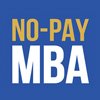by Laurie Pickard | Dec 28, 2013 | MOOC MBA Design

Crafting your own No-Pay MBA requires a bit more creativity than simply enrolling in an off-the-shelf business program. That said, the process is fun, and it allows for plenty of flexibility – and of course an enormous savings. Here’s how to do it:
1. Ask yourself: What do I hope to achieve by getting an MBA?
Your goal should be realistic and attainable. You will probably want to determine if your needs are better served by getting a traditional MBA. For example, if you want to be a Wall Street investment banker or stock broker, you might need the connections and the cred that come with a traditional MBA. However, if you want to start your own business, advance in your current job, or be eligible for jobs related to your current field that require an understanding of business, a No-Pay MBA could be perfect for you. You can see more of my thinking on this topic here. You might even float the idea to your supervisor by saying something like, “I’m looking into taking business courses. Would it be possible for me to take on some new responsibilities as I acquire new skills?”
2. Ask yourself: Do I have the time to commit to earning an MBA?
This is a very important step. You should budget at least four hours per week per course. If you plan to take two courses at a time (which is what I am doing), then you should expect to spend eight hours each week doing coursework. When I first started my No-Pay MBA I was between jobs, and I loaded up on courses, taking four at once, which was practically a full time job! Now that I’m working, I don’t have time to listen to lectures and do homework during the week, so I block off Saturday mornings to work on my MBA.
3. Make a list of topics you want to cover
I made my checklist by consulting the curriculum pages on the websites of Wharton, Harvard Business School, MIT’s business school, and a couple of others. You could do the same, or you could use the checklist below. I would caution against trying to duplicate my MBA or any other MOOC-based MBA course for course – as per the recommendation in this article, for example – because course availability is not guaranteed from semester to semester. Rather, I would focus on one set of topics during the first year (or first half) and a second set of topics during the second year/second half of your MBA. Check out this post and this page to see how I’ve done my first year.
A general checklist is as follows:
First year
These core courses:
o Accounting
o Corporate Finance
o Marketing
o Management (I would recommend at least two courses in management in the first year. These could include operations management, project management, leadership, small business management, etc.)
Plus three of the following:
o Technology in business
o Microeconomics
o Business ethics
o Organizational psychology
o Human resources management
o Entrepreneurship
o Business innovation
Second year
o Advanced topics in finance, corporate valuation, or accounting
o Business planning
o Business ethics
o Advanced topics in management
o Supply chain management
o Three to four courses related to an area of particular interest (mine is sustainable supply chain management for agri-business)
4. Set ambitious but realistic targets
Now that you have your checklist and you’ve made a commitment to spend time working on your MBA, figure out how many courses you can take each semester and how long it will take you to finish your MBA. Your biggest challenge will be staying motivated, so I suggest holding yourself to a tight timeline. Remember that MOOCs tend to be shorter that regular courses, so you can do more of them in a year. I’m planning to finish my MBA in under 3 years, while working full time.
5. Look at this list and register for courses
As far as I can tell The MOOC List is a complete listing of free courses from all the major MOOC providers. By checking the “business and management” category frequently, you’ll stay up to date on all the free courses that might relate to your No-Pay MBA.
6. Start racking up the SOAs!
Before you know it, you will have a (virtual) pile of Statements of Accomplishment, certificates of completion, and other documentation to show that you are mastering the skills you’ll need in the world of business. As I’ve mentioned previously, I’m still skeptical of Statements of Accomplishment and the like, and I’m not convinced that you should pay anything to receive them. However, I recommend at least keeping a record of the courses you’ve completed and the skills you’ve learned so that you can present them to future employers.
7. Let me know how your No-Pay MBA is going
Okay, this last step isn’t strictly necessary, but I’d love to hear from you. And I’ll make you a deal. If you write to me and tell me that you’re doing a No-Pay MBA, I will post your picture and a short write up about your background, your course of study, and your career goals to my website.
by Laurie Pickard | Dec 20, 2013 | MOOC MBA Design, Thoughts on Higher Ed and Life
By far the biggest challenge when taking an online course is maintaining motivation. With no professor to praise you, no fellow students to foster competition, and – in a MOOC, at least – no credit-granting institution to hold you accountable, you have only your own will power and determination to get you through. Finishing one course – let alone enough courses to add up to a degree - requires a disciplined, intrinsically motivated student.
The numbers tell a similar story. The New York Times recently reported on a University of Pennsylvania study on MOOCs whose headline stats included the fact that fewer than 4% of students finish the courses they register for, and 80% of those enrolled in MOOCs already hold a university degree. These results prompted Forbes to ask if MOOCs are in fact failing in their mission of democratizing education.
To my mind, it’s much too early to label MOOCs a failure. The fact that so many people are interested enough to register for these courses – regardless of whether they finish them – indicates the vast potential of MOOCs. Besides, there are plenty of good reasons why a person might sign up for a course and not finish it. Maybe they were simply curious about the whole MOOC phenomenon and never intended to take a whole course. Maybe they understimated the amount of work involved. Maybe they started the course and then decided the assignments weren’t worth their time. (I’ll be honest, I’ve definitely shirked some assignments in my current MOOC. Don’t even get me started on how much I hate it when 120,000 students are given the assignment of posting a comment on a class-wide discussion forum.)
It all boils down to motivation.
So what might make it easier to sustain the motivation required to finish an online course? Anything that makes the student more socially accountable. Nobody wants to be seen as a slacker or a quitter, but as an anonymous student in an online class it hardly matters if you complete your assignments or not.
My personal solution to the motivation problem is to blog about my courses. Because I’ve made a personal commitment to write about my MBA experience in a public forum, I’m motivated to complete my courses – both to have new material to write about and to make good on what I’ve set out to accomplish.
But any strategy that fosters social accountability could have a similar effect. For example, telling friends and family that you plan to take a course can make it more likely that you’ll finish it. Discussion forums with thousands of students are useless, but a study group – even a virtual one – with just a few students could provide the necessary social accountability. Even better would be a live discussion section with a mentor or facilitator.
For me, the most difficult assignments are those that involve writing or creating something. Problem sets and multiple choice quizzes are easy by comparison. So I’m telling you now, I plan to work harder on creative assignments next semester. You can hold me to that.
by Laurie Pickard | Nov 15, 2013 | MOOC MBA Design, Most popular posts
“A dollar today is worth more than a dollar tomorrow.” Most of us have probably heard someone say something to this effect. We understand intuitively that a dollar in hand is preferable to a dollar some future date. But why is this true?
Turns out it is possible to calculate exactly how much more a dollar today is worth than a dollar tomorrow, five years from now, or twenty years from now. The discount rate, otherwise known as the rate of inflation, can be used to take today’s dollar and translate it into future dollars – or to figure out how much a future amount of cash would be worth today.
This type of analysis is a powerful tool for determining whether a given investment is a good idea or not. To do this, you simply compare the amount of the investment to the predicted future cash flows from the investment, discounted back over the life of the project. Simple. This analysis is known as the net present value (NPV) of the investment - in other words, how much the whole investment is worth in today’s dollars.
What is the value of The No-Pay MBA? Or of any MBA for that matter? Answering this question is fairly simple – it just requires making a few assumptions.
First, let’s assume that the No-Pay MBA is not in fact completely free. Let’s say I end up spending around $1000 up front. This covers what I’m paying for internet access, web hosting, wear and tear on my computer, business books I’m buying, and other expenses.
Second, I’m assuming that there is no opportunity cost of The No-Pay MBA. It’s not taking time away from other employment, it’s not keeping me from doing any kind of paying work, and there is nothing else I could be doing with the time I spend working on my MBA that would result in monetary compensation.
Third, I’m assuming that I’ll be able to leverage this project to get a higher salary in the future. Let’s say as a result of having done the No-Pay MBA I’m able to earn $5,000 additional income per year starting a year after I finish.
Finally, I’m assuming a 3% interest rate.
The calculation can be done in Excel, and it looks something like this:
| Year |
Additional income or expense |
NPV |
|
0
|
$(1,000.00)
|
$(1,000.00)
|
|
1
|
$-
|
$-
|
|
2
|
$-
|
$-
|
|
3
|
$5,000.00
|
$4,575.71
|
|
4
|
$5,000.00
|
$4,442.44
|
|
5
|
$5,000.00
|
$4,313.04
|
|
6
|
$5,000.00
|
$4,187.42
|
|
7
|
$5,000.00
|
$4,065.46
|
|
8
|
$5,000.00
|
$3,947.05
|
|
9
|
$5,000.00
|
$3,832.08
|
|
10
|
$5,000.00
|
$3,720.47
|
|
11
|
$5,000.00
|
$3,612.11
|
|
12
|
$5,000.00
|
$3,506.90
|
|
13
|
$5,000.00
|
$3,404.76
|
|
14
|
$5,000.00
|
$3,305.59
|
|
15
|
$5,000.00
|
$3,209.31
|
|
16
|
$5,000.00
|
$3,115.83
|
|
17
|
$5,000.00
|
$3,025.08
|
|
18
|
$5,000.00
|
$2,936.97
|
|
19
|
$5,000.00
|
$2,851.43
|
|
20
|
$5,000.00
|
$2,768.38
|
|
21
|
$5,000.00
|
$2,687.75
|
|
22
|
$5,000.00
|
$2,609.46
|
|
NPV of No-Pay MBA |
$69,117.23
|
After adding up the present value of each years’ worth of additional salary, it turns out that after 22 years, the No-Pay MBA is worth $69,117.23!!!! Wow!
But let’s say I can’t get $5,000 additional salary each year. Let’s say I can only get $2,000 additional salary. In that case, the No-Pay MBA is only worth $25,216.61. That’s still a lot given how little it’s costing me.
Or what if I can only get a one-time salary bump of $3,000 some time in the middle or my career – let’s say after 7 years. In that case, the No-Pay MBA is only worth $1,439.
Going through these calculations for different assumptions is called sensitivity analysis. I’ve played around with my assumptions, but no matter how you slice it, the No-Pay MBA is a good value. In corporate finance, any investment with an NPV that is a positive number is considered a good investment.
By contrast, a regular business degree comes with a much higher price tag, as well as a much greater opportunity cost. I’ve also estimated how much money I would have to earn each year in order to justify the expense of a traditional MBA. Assuming a total cost of $250,000 (including the opportunity cost of lost years of salary), I would have to earn $15,500 in additional income every year just to break even. I don’t mean to bad mouth traditional MBA programs – and it isn’t actually very far fetched that someone with that degree could earn an additional $15,000 per year, or even a lot more than that. But given my industry and the fact that I’m the trailing spouse of a foreign service officer, the free option seems like a much safer bet.
by Laurie Pickard | Oct 15, 2013 | Courses, Platforms, and Profs, MOOC MBA Design
I recently finished my first Coursera course and received a Statement of Accomplishment. The Statement of Accomplishment is Coursera’s answer to my question in a previous post. For some of my courses students are invited to pay for a “Verified Statement of Accomplishment” by joining a “signature track” for the course. The coursework is the same, but only the paying students get the verified statement at the end. I respect Coursera’s efforts at bringing legitimacy to free coursework, but I don’t place a lot of value on the Statement of Accomplishment, primarily because the level of difficulty is highly variable from course to course. The class for which I received my first Statement of Accomplishment was interesting, but incredibly easy. I listened to the lectures each week, but I could have answered each week’s five-question quiz correctly without having done so. In contrast, last week I spent a couple of hours on the homework for my Intro to Operations Management course and had to re-watch a couple of the video lectures.
Of course, some of my college classes were pretty easy too. I once took a class called “Geology of the National Parks,” which I and the entire football team were using for our science requirement. I also got credit for an elective swimming class. But my overall degree program is what ended up counting - no employer has ever asked to see the titles (or my grades, for that matter) of individual courses.
The Statement of Accomplishment is a good start, but I would like to see Coursera (and others) offer something closer to a degree - a Statement of Accomplishment that covers multiple courses and recognizes the totality of study. If such a thing were available I might even be willing to spend a few bucks to get one.
by Laurie Pickard | Oct 1, 2013 | Courses, Platforms, and Profs, MOOC MBA Design, Thoughts on Higher Ed and Life
Just a couple of weeks ago the University of Pennsylvania’s Wharton School of Business announced it was putting free versions of its first year MBA courses on Coursera. I am taking two of these courses, and they are top notch – so good, in fact, that I think I may have missed a calling as an accountant (more on that in another post). I am of course thrilled that one of the top-ranked business schools in the US has decided to make its first year curriculum available free of charge, but why would Wharton give away this material, which is basically the same product it is selling to its regular students? Granted, Wharton isn’t granting any academic credit to people who complete these courses, but the material is the same as in the paid versions. This begs the question, isn’t Wharton undercutting its ability to attract paying students by giving away the same product it charges for? There are three reasons I can think of why the school might consider it a good idea to give away the milk from this particular cow.
- Wharton believes there is no overlap between potential paying students and students interested in taking courses for free.
- Wharton hopes to use these free courses to attract paying students.
- Wharton believes that value of its MBA lies in the degree granted by the institution, not in the skills and knowledge embodied therein. Wharton assumes that potential students will also see it this way.
In order for Wharton (and other schools) to post their courses online without risking losing their core business, they must believe in the third conclusion. Indeed, signaling is quite important when it comes to degrees of all types. If your resume says Harvard or MIT or Yale, or any of the set of big-name schools, that’s a strong signal that you a) were accepted by a prestigious school, and b) performed well enough in that environment to have graduated. Does a Statement of Accomplishment from Coursera have the same effect?
I tend to think not, so I was surprised when a decision by the instructors of my International Organizations Management course not to offer a Statement of Accomplishment option sparked a firestorm of comments on the course discussion forum. Nonetheless, when I tell people I am designing my own MBA program from free online courses, the most common question I get asked is, are you getting credit? No, I’m not. But I believe that the coursework is intrinsically valuable, with or without the piece of paper.
For me, this project’s success hinges on three things:
- The availability of enough high-quality free course material to equal what is offered in an MBA degree program. Thanks to Coursera, edX, and others, check.
- My ability to complete the courses and to absorb the information. So far, also a check.
- Future employers believing that I have acquired useful skills and knowledge through this endeavor.
The last criteria is as yet an unknown. Admittedly, my method of bringing legitimacy to my self-made MBA – blogging – is remarkably inefficient. I enjoy doing it, and I think it’s necessary if anyone at all is to take me seriously. Practically speaking, however, I can mention my project in a job interview, or even put a line or two on my resume, but an employer would need to dig a little in order to see that I really do have the skills that come with a traditional MBA. And even if he or she read my blog, they would still have to take my word for it to some extent. That takes a lot longer - and requires more trust - than reading the words “Wharton School of Business” on a CV.
Much of the discussion in the book College Unbound, one of several new books on the subject of how post-secondary education is changing, centers on how students who don’t do traditional degree programs can signal that they have acquired skills that employers desire by other methods. The information is out there, but it remains to be seen how online courses can go beyond personal edification and translate into increased job prospects. I’m optimistic about the possibilities, but we’ll all have to wait and see.
by Laurie Pickard | Aug 9, 2013 | MOOC MBA Design
I am modeling my No-Pay MBA on top-flight MBA programs such as Harvard, Stanford, UPenn, and MIT. The first year of a degree program at these universities typically focuses on fundamentals. The second year, students get to take more elective courses. The core curriculum for the first year usually includes some subset of the following:
- Finance
- Accounting
- Leadership, managerial skills, and organizational psychology
- Business ethics
- Technology and operations management
- Marketing
- Microeconomics
In my first year, I plan to do coursework in all of these areas. My overall strategy is to take 16 courses over two to three years. I will take two courses at a time for 3 months at a time. At that rate, I can do eight courses in a year.
Some of the courses I have found are traditional ones that are set up on a semester schedule, with required readings and homework. For technical topics, such as finance and accounting, I will make a point of seeking out such courses. For topics that are less technical - such as leadership - I will try to incorporate a diversity of opinions by taking shorter courses, listening to lecture series, and reading books on the subject.
For anyone reading who has done an MBA, how does this list look to you? Am I missing anything critical in my first year curriculum? Is there anything here that you would leave out or replace with something else?






